With the increasing global emphasis on clean energy, photovoltaic (PV) power plants have emerged as a vital renewable energy source. However, over time, dust, bird droppings, and other pollutants can accumulate on solar panels. This not only diminishes electrical efficiency but also affects the economic performance of the power plants. Therefore, developing scientifically sound cleaning strategies and optimal cleaning cycles is crucial.

Importance of Cleaning Strategies
Regular cleaning of PV modules can significantly boost the power output of solar plants. Studies show that effective, periodic cleaning maximizes the benefits of power generation. However, excessive cleaning may increase operational costs. It is essential to strike a balance between cleaning frequency and economic efficiency. Currently, there are no universally accepted cleaning standards or cycles, and most power plants assess the need for cleaning based on surface dust accumulation and fixed time intervals.
How often should the solar power station be cleaned
Arid Regions (e.g., Middle East)
- March to April: Dust storm season; dynamic cleaning is recommended based on dust accumulation.
- May to October: Monthly cleaning is advised.
- November: A comprehensive cleaning should occur, while cleaning in December and January may not be advisable due to lower temperatures.
Subtropical Monsoon Climate and Similar Global Regions
Regions with climates similar to China’s Central region often experience rainy seasons that can aid in cleaning.
- March to April: Take advantage of the rainy season for thorough cleaning.
- May to October: Perform cleaning before the peak power generation season.
Rainy Regions
- It is recommended to clean PV panels 3 to 4 times a year to maintain their cleanliness effectively.
Dust Accumulation and Timing for Cleaning
When dust accumulation reaches 90 to 100 grams per square meter, cleaning should be organized immediately. This typically occurs in high dust accumulation months like spring and autumn. For instance, research in arid regions, like Qinghai in China, indicates that from October to April, cleaning every 2 to 3 months can meet operational requirements.
Economic Benefits Analysis
Specific case studies illustrate that timely cleaning can significantly enhance power generation revenue. Examples include:
- Fengli Phase I Solar Power Plant: Data indicates that cleaning every 7 weeks maximizes revenue from rooftop modules.
- Jeff’s Station: An annual cleaning can yield an additional revenue of ¥40,700; with two cleanings, the increment is ¥35,500.
- Laoheng He Station: Cleaning four times a year results in a net income of ¥93,200.
Cleaning Cycles Based on Pollution Levels
The optimal cleaning cycle for photovoltaic power plants should dynamically adjust based on pollution severity and environmental conditions.
- La contaminación leve requiere limpieza cada 7 semanas.
- Contaminación moderada cada 1-2 meses
- Contaminación severa cada 1-2 semanas
A continuación se presentan las recomendaciones de limpieza basadas en diferentes escenarios:
- Zonas desérticas:Leve: semanalmente, Moderado: 1 a 2 veces por semana, Grave: cada 3 días.
- Áreas rurales:Leve: cada 2 meses, Moderado: 1-2 meses, Grave: mensualmente.
- Áreas urbanas:Leve: mensual, Moderado: 1-2 veces al mes, Grave: semanal.
- Áreas industriales:Leve: semanalmente, Moderado: 1-2 veces por semana, Grave: cada 3 días.
- Zonas costeras:Leve: cada 3 meses, Moderado: cada 2 meses, Grave: mensualmente.
- Áreas agrícolas:Leve: cada 2 meses, Moderado: 1-2 veces al mes, Grave: mensualmente.
Consulte el método de cálculo detallado:Fórmulas de cálculo de los efectos de limpieza y los intervalos de limpieza de plantas fotovoltaicas
Development of Intelligent Cleaning Technologies
Although manual cleaning remains the most commonly used method, it is less efficient. With rising labor costs and advancements in intelligent robot technology, manual cleaning will gradually be replaced by cleaning robots. These robots enable higher frequency automated cleaning, e.g., cleaning every three days, significantly improving the efficiency of solar power generation.

Unique Advantages of Todos Máquinas de limpieza automatizadas
Intelligent Cleaning: The equipment can automatically sense the level of dust accumulation and determine cleaning needs based on weather conditions and actual power generation data, requiring no human intervention.
High Safety: The equipment operates safely and reliably during cleaning, ensuring high stability to prevent damage to PV modules.
Micro-water or Waterless Cleaning Technology: This technology allows for effective cleaning in areas with limited water resources or cold weather, thus reducing costs and improving cleaning efficiency.
Conclusión
The frequency of cleaning PV power plants should be dynamically adjusted based on actual dust accumulation, weather conditions, cleaning costs, and electricity generation losses to achieve optimal economic benefits. The best cleaning cycles may vary across different regions; therefore, scientific and rational planning that considers specific environmental and meteorological factors is essential. By adopting intelligent cleaning technologies, solar power plants can not only enhance energy production efficiency but also better adapt to the changing environmental challenges across the globe, ensuring that regions worldwide can effectively maintain their solar energy systems.